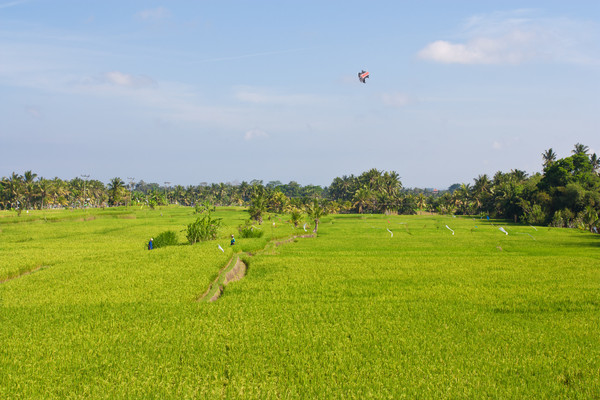
Indian agriculture, the challange of productivity
The Indian subcontinent represents one of the largest producers of agricultural commodities worldwide. However, with regard to cereals, the productivity of some regions is still significantly below that recorded in the main producing countries. The production of fruit and vegetables is consistent, with a diversifying and expanding offer
In the fiscal year 2013-2014, according to the Advance Estimates by the local Ministry, Indian agriculture set a series of records related to production that confirmed India, also thanks to an extension of 3.2 million km² and an agricultural area of 140 million hectares, as one of the leading producers on a global scale. Considering that over the years the geography of agriculture of this country has remained largely unchanged, below is an overview of the main crops of India and especially of the numbers that have established these new records.
Grains still play an important role in Indian agriculture: the total amount of foodgrains in the year 2013-2014 corresponded to 264.77 million tons, with an increase of 3% compared to the previous year. Going into the details, with 106.54 million tons (+1% compared to the previous fiscal year), India has been confirmed as the second largest rice producer after China. Among the states that make up the Indian union, West Bengal is the largest producer with 15.31 million tons, followed by Uttar Pradesh and Andhra Pradesh with 14.63 and 13.03, respectively. The year 2013-2014 was, thanks to a production increased by 3%, also the best year ever for grain, the production of which reached 95.91 million tons, mainly from Uttar Pradesh (30.25), Punjab (17.04) and Madhya Pradesh (13.93). The states of Andhra Pradesh (4.97), Karnataka (3.98) and Maharashtra (3.08) were the main producers of maize, with a harvest of 24.35 million tons throughout the country.
However, field profitability, with regard to cereals, is still in many cases largely inferior to the world average, as highlighted by a study conducted by the Federation of Indian Chambers of Commerce and Industry on the basis of the 2012 data. Rice for example, with a value of 3,512 kg/ha, is not only much below China, the first producer in the world with 6,661 kg/ha, but also below the world average of 4,397 kg/ha. Apparently better is the situation concerning grain, with a productivity in line with the world average of 3,094 kg/ha, although less than the half of a field in the United Kingdom, amounting to 7,360 kg/ha. The most striking example is that of maize, with the United States holding the record with 8,858 kg/ha and the world average of 5,097 kg/ha, while in India this figure only amounts to 2,321 kg/ha. At this point we cannot help to think that the numbers would be definetely different if field profitability in India were in line with the world average or with the main producers. By applying the values of the average productivity, the amount of grain would remain essentially unchanged, while rice and maize would increase to 133 and 53 million tons, respectively. In case India reached a top of the class productivity, yield levels would amount to 202 million tons of rice, 236 million of grain and 93 million of maize.
Turning to horticulture crops, a category that in India includes fruit, vegetables, “plantation crops” (such as cashews and coconut) and spices, the total exceeds 280 million tons (they were almost 269 million in 2012-2013), including 86 of fruit and 168 of vegetables. With regard to fruit, India remains an important producer of bananas (29.5 million tons), tropical fruit (17.93 million tons of mango, 5.57 of papaya and 3.63 of guava) and citrus (10.48 million tons). Grape growing deserves, within fruit production, a specific mention: the hectares of vineyard area in India, more than two-thirds of which are located in the State of Maharashtra, are 116,000. From these, 2.5 million tons of grapes are collected annually. The hectares devoted to growing vegetables are 9.57 million: potatoes, onions, tomatoes and eggplants dominate the category of the cultivated spieces, with the amounts of 44.30, 19.77, 19.19 and 13.84 million tons, respectively. The last figures belong to plantation crops, with 16.60 million tons and spices with 5.93.
With a 12% below the average monsoon rainfall, it will be difficult to beat again such records in the year 2014-2015. On the contrary, the first estimates relating to the Kharif harvest (ie the one carried out during the monsoon season) reveal a drop in production of 6.94% in 2014 with regard to foodgrains, resulting in a difference of nearly 9 million tons. In particular, still with regard to the Kharif , rice production decreased of 4%, that is nearly 4 million tons less than the previous year.
At the end of this brief review of the main issues of the primary sector in India are the interesting, and in many cases staggering, figures related to farming: the latest estimates, although for the year 2007, describe a population of 304 million cattle, 140.5 million goats, 71.6 million sheeps and 648.8 million chickens, ducks, turkeys and other birds. From this huge animal population, in 2013-2014 were obtained 47.9 million kg of wool, 137.7 million tons of milk and 73.4 billion eggs.








